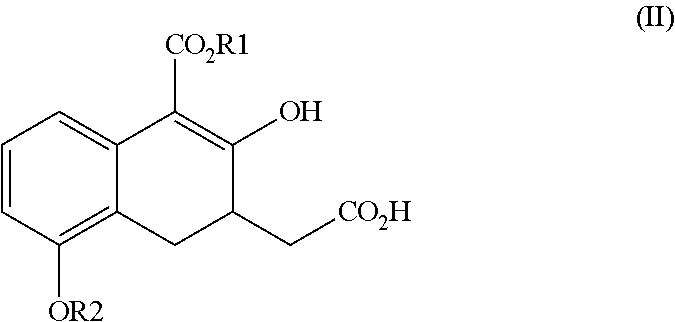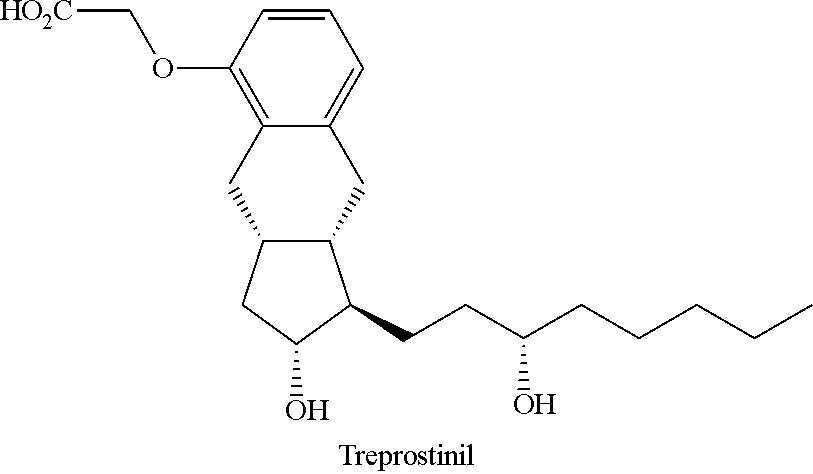Novel intermediate for synthesizing treprostinil diethanolamine and method for preparing the same
a technology of treprostinil diethanolamine and intermediate, which is applied in the preparation of carbonyl compounds, heterocyclic compounds, organic chemistry, etc., can solve the problems of time-consuming and complex existing methods for treprostinil synthesis, and achieve the effects of improving the tedious and lengthy synthetic process, increasing the purity of intermediates, and high optical purity
- Summary
- Abstract
- Description
- Claims
- Application Information
AI Technical Summary
Benefits of technology
Problems solved by technology
Method used
Image
Examples
example 1
Preparation of Compound 1 —Methoxycarbonyl Reaction (i)
[0050]
[0051]An amount of 500 g of 5-methoxy-2-tetralone was dissolved in 3.75 L of dimethyl carbonate. At 15° C., 633 mL of 30% methanolic sodium methoxide solution was then added. The reaction solution was next heated at 70° C. for 1 h. After the reaction solution was cooled to room temperature, the reaction was quenched by 1.2 L of 3N aqueous hydrochloric acid. The organic layer was separated and the aqueous layer was extracted using 1 L of ethyl acetate. The combined organic layers were concentrated in vacuum. The resulting crude product was extracted using 3.29 L of hexane and filtered. The filtrate was concentrated and dried to yield 531 g of compound 1 as yellow solid.
example 2
Preparation of Compound 2 —Alkylation Reaction (ii)
[0052]
[0053]A solution of 143 mL of diisopropylamine was dissolved in 1 L of THF. At −60° C., 272 mL of 1.6 M n-butyl lithium in n-hexane was added dropwise and stirred for 15 min at −60° C. 92 g of compound 1 dissolved in 600 mL of THF was then added dropwise and stirred for 1 h at −60° C. Next, at 5° C., 68 g of lithium bromoacetate
and 29 g of tetrabutylammonium iodide (TBAI) were then added. The reaction solution was stirred for 22 h at room temperature. The reaction was then quenched by 1.5 L of 2N aqueous hydrochloric acid at 5° C. After the organic layer was separated, the organic layer was washed twice using 1.5 L of 2N aqueous hydrochloric acid. The organic layer was then concentrated in vacuum to yield 110 g of compound 2 as off-white solid. In particular, this compound 2 is a preferred embodiment of the novel intermediate of the present invention. 1H NMR (CDCl3, 400 MHz) δ 7.33-7.31 (d, J=8.0 Hz, 1H), 7.18-7.14 (t, J=8.0 H...
example 3
Preparation of Compound 3—Decarbomethoxylation Reaction (1-1)
[0054]
[0055]A mixture of 340 g of compound 2 and 54 g of lithium chloride (LiCl) was dissolved in DMAc / H2O (1.7 L / 68 mL). The reaction solution was heated to 100° C. for 2 h and then cooled to room temperature. 1.5 L of saturated brine and 1 L of ethyl acetate were added to begin partitioning. The organic layer separated was washed using 4.5 L of saturated brine. The washed organic layer was concentrated in vacuum to yield 225 g of compound 3 as orange solid.
PUM
| Property | Measurement | Unit |
|---|---|---|
| temperature | aaaaa | aaaaa |
| temperature | aaaaa | aaaaa |
| temperature | aaaaa | aaaaa |
Abstract
Description
Claims
Application Information
 Login to View More
Login to View More - R&D
- Intellectual Property
- Life Sciences
- Materials
- Tech Scout
- Unparalleled Data Quality
- Higher Quality Content
- 60% Fewer Hallucinations
Browse by: Latest US Patents, China's latest patents, Technical Efficacy Thesaurus, Application Domain, Technology Topic, Popular Technical Reports.
© 2025 PatSnap. All rights reserved.Legal|Privacy policy|Modern Slavery Act Transparency Statement|Sitemap|About US| Contact US: help@patsnap.com



